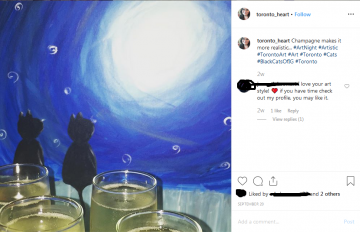 Back in the summer, I had what I thought was an excellent idea. I would open a new Instagram account and, for one month, try to live life like an influencer. I hoped it would be an experiment that shed some light on the impact living a public digital life could have on a person. I planned to post at least one photo per day on this new account, use hashtags within an inch of my life, and see what happened. In many ways, this experiment failed. The results, however, were more interesting than I could have predicted. Let me explain.
Back in the summer, I had what I thought was an excellent idea. I would open a new Instagram account and, for one month, try to live life like an influencer. I hoped it would be an experiment that shed some light on the impact living a public digital life could have on a person. I planned to post at least one photo per day on this new account, use hashtags within an inch of my life, and see what happened. In many ways, this experiment failed. The results, however, were more interesting than I could have predicted. Let me explain.
By nature, I am a pretty private person. I keep the security settings on my social media accounts pretty tight. My Facebook and (personal) Instagram accounts are locked down to the max, and my Twitter and LinkedIn are such that while strangers can interact with my posts and see my profile, they cannot privately message me. It is not in my nature to share much about my personal life on these platforms, even on those which are more securely protected. In my daily life, social media is essentially a news source. It keeps my apprised of what’s happening in politics and with my friends, and that is all I want or need it to do. I don’t post many photos of myself (or my meals), I don’t make my relationship status public, and I don’t share much of my personal life. I have nothing against people who do use social media this way; it just isn’t in my nature.
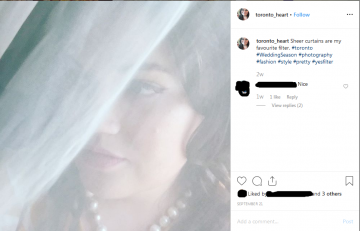
Embracing my inner influencer.
I thought it would be interesting to see what happens when you take a person like me, who is so averse to sharing their personal life on social media, and make them publicly share their life for a month. I had a few hypotheses:
- I thought such an experiment would have an impact on my self-esteem (either comparing myself to true influencers would impact it to the detriment of my self-esteem, or the validation of “likes” would improve my self-esteem).
- I also thought that I would become more reliant on Instagram, an app that I generally check very rarely.
- Finally, I figured that after some time, Instagram would come naturally to me, and that it would become second nature to snap a photo of my salad (or more realistically, an entire baguette eaten in one sitting) or to ask a friend to grab a photo of me on a patio.
You know what they say about the best laid plans? Well, that’s nothing compared to poorly laid plans.
There were a few problems with my experiment. Primary among them, I did not do enough research. Beyond scrolling through the Instagrams of a few influencers, I did not adequately prepare for trying to be one. I didn’t have a posting schedule or pre-planned posts, which meant that my initial goal of posting something daily turned into me posting whenever I remembered to, which was…not often.
Second, I didn’t decide in advance what kind of persona I was going to use for this account. Would I be myself, taking photos? Or would it be better to adopt an influencer-esque persona? The result of not making this decision in advance was that the person presented in my faux-Instagram account is a strange combination of these two approaches, which is really the worst of both worlds. Between having no idea what I was doing (and as it turns out, being an influencer takes a ton of time and work), no consistency in posting, and no clear identity for my account, it seemed to me like my account was completely doomed.
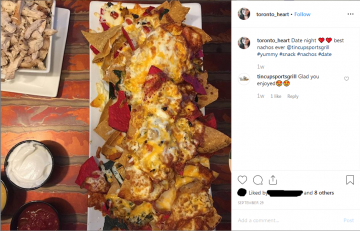
Shout-out to Tin Cup Sports Grill for not calling me “babe.”
Except… it wasn’t. To be sure, I did not become Instagram famous, I am in no way an influencer, and my follower count is lower even than my private, personal Instagram account. However, my faux-Instagram is still a pretty active account relative to its contents. I have six posts (three of me, one of food, one of a cafe, and one of an evening paint night), 46 followers, and multiple men in my inbox messaging me with variants of “hey” “hey” “hey” every day. Despite my neglect of this account, my experiment transformed into one about the realities of being a woman on the Internet.
Now, I have of course been a woman on the Internet for as long as I have been using the Internet. I have even written before about how I have been harassed online. However, these things were always isolated incidents, one-offs that occurred on the odd public forum or comments thread. Never before have I been in a position where random people could message me, because that isn’t something that ever occurred to me as a good idea. And here I was, inbox open, and the first message I got was a man offering to be my sugar daddy.
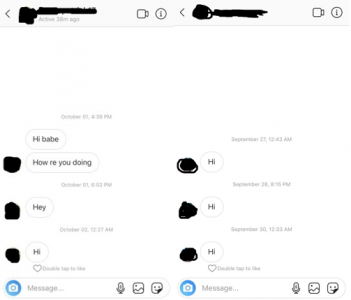
Pure poetry.
It took some getting used to, this messaging. It went from making me extremely uncomfortable to being a bit of a nuisance, and now, to being just annoying. The number of times I have been called “babe” in the past month by strangers probably now totals more times than I have ever been hit on by strangers in my life.
During a Digital Tattoo team update on the progress of this experiment, a colleague asked if any women had messaged me, or if it had been just men. That’s when I realized it was just men.
Some of these interactions made me very uncomfortable (the man asking me to be his sugar baby who, when I said no, pushed the matter), and some were surprisingly–and strangely–pleasant (the man who sent me videos which I was terrified to watch, but turned out to be lovely clips of the beautiful Pakistani countryside taken from his car). Often they were boring and repetitive, repeating some variation of “hi” four times before giving up messaging me.
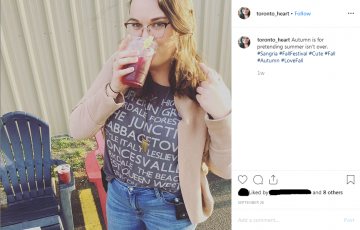
One of the rare occasions on which I remembered to document my activities.
Frankly, this experience made me wonder how other women do it. Because of the security settings and my lack of personal photos on my regular social media accounts, unsolicited messaging is a rarity for me. I’ve of course experienced it, but always as one-offs, not as a constant deluge. And for women whose accounts are more active and interesting than this experimental account was, it’s significantly worse. I understand that women have public accounts for a variety of reasons, and that those reasons are all valid. This is not a criticism of women for being open and public with the world. Rather, it’s a criticism of those people (in this case, exclusively men) who use that openness as an opportunity to pick women up. This experiment was, in its essence, simply a reminder that unless I (digitally) lock myself away from the masses, I can’t exist online without being bothered multiple times a day by strangers trying to pick me up (and in some cases, possibly catfish me).
I’m glad I did this experiment. It’s great to stay aware and in touch with these realities of an online presence which my secure bubble keeps me protected from. It reaffirmed my preference for keeping my social media accounts locked down. It also made me wonder what our readers prefer. Do you keep your accounts relatively open and therefore yourself accessible, or have you also locked yourselves away in digital towers?
I will definitely be deleting this account now that this experiment is done.
I didn’t get any better at taking selfies.
Written by Samantha Summers
Edited by Eseohe Ojo
Photos provided by Samantha Summers

